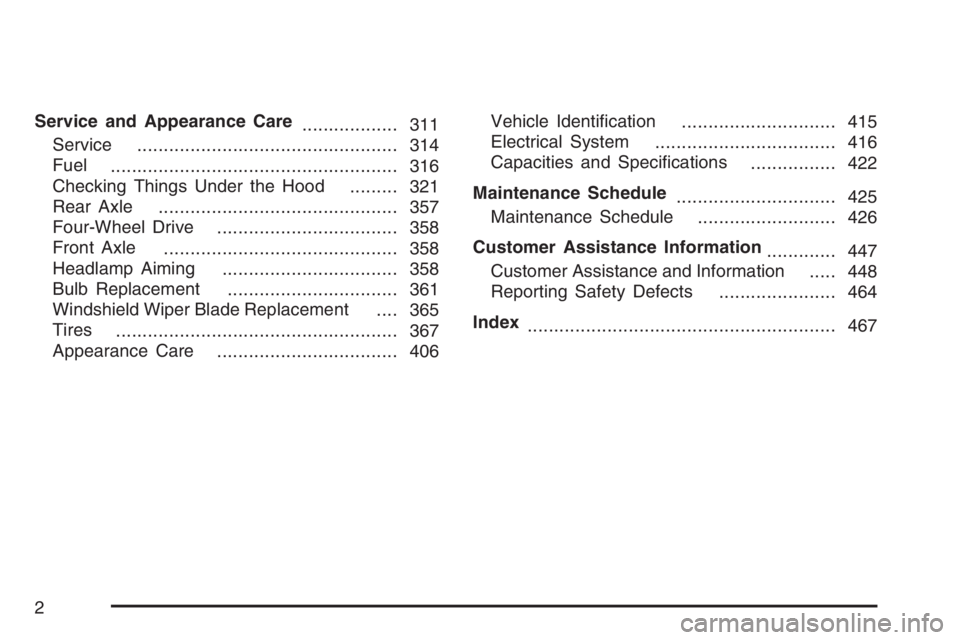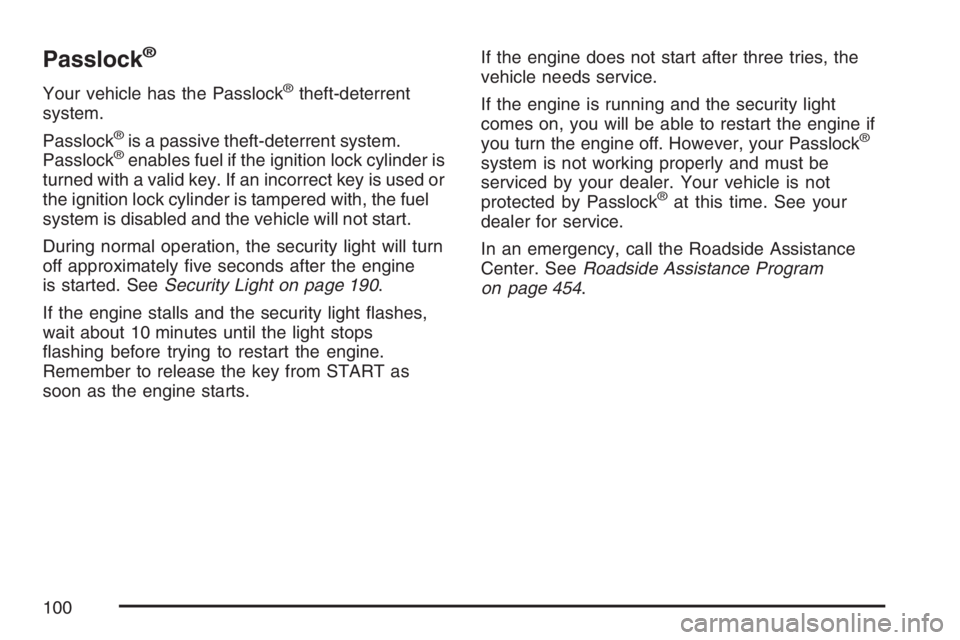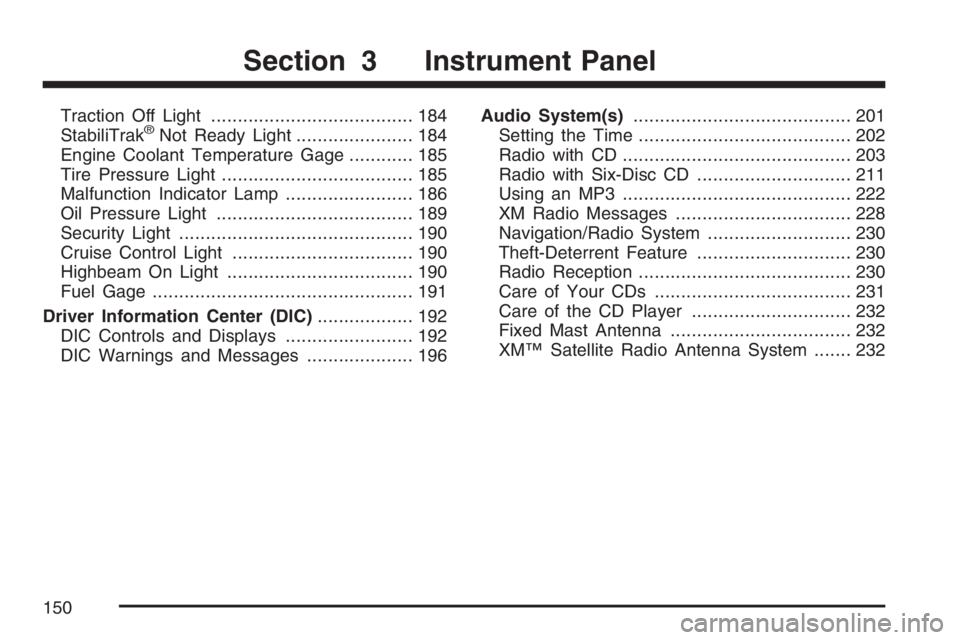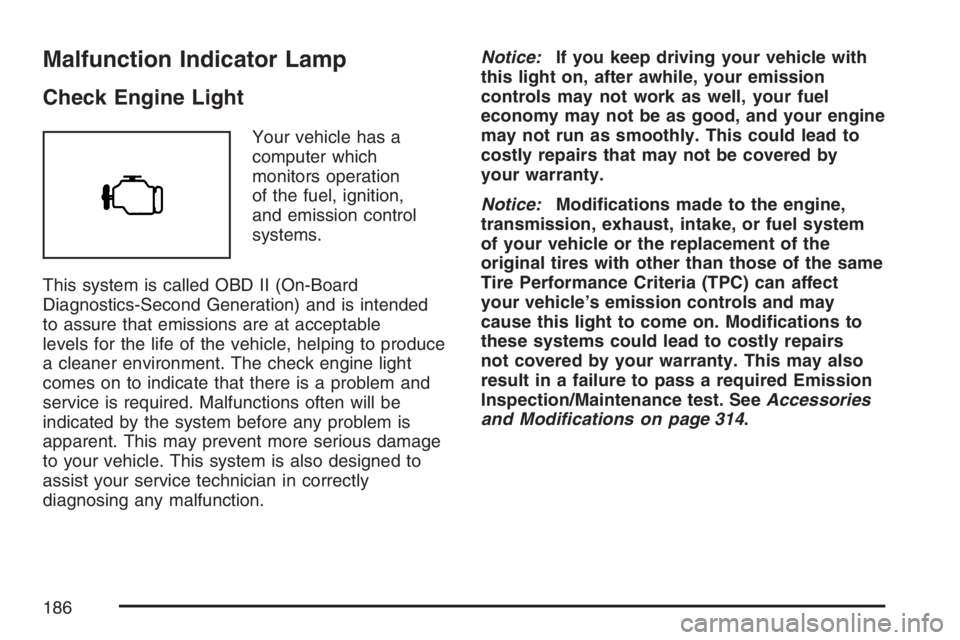fuel HUMMER H3 2007 Owners Manual
[x] Cancel search | Manufacturer: HUMMER, Model Year: 2007, Model line: H3, Model: HUMMER H3 2007Pages: 480, PDF Size: 2.73 MB
Page 2 of 480

Service and Appearance Care
.................. 311
Service
................................................. 314
Fuel
...................................................... 316
Checking Things Under the Hood
......... 321
Rear Axle
............................................. 357
Four-Wheel Drive
.................................. 358
Front Axle
............................................ 358
Headlamp Aiming
................................. 358
Bulb Replacement
................................ 361
Windshield Wiper Blade Replacement
.... 365
Tires
..................................................... 367
Appearance Care
.................................. 406Vehicle Identi�cation
............................. 415
Electrical System
.................................. 416
Capacities and Speci�cations
................ 422
Maintenance Schedule
.............................. 425
Maintenance Schedule
.......................... 426
Customer Assistance Information
............. 447
Customer Assistance and Information
..... 448
Reporting Safety Defects
...................... 464
Index
.......................................................... 467
2
Page 100 of 480

Passlock®
Your vehicle has the Passlock®theft-deterrent
system.
Passlock
®is a passive theft-deterrent system.
Passlock®enables fuel if the ignition lock cylinder is
turned with a valid key. If an incorrect key is used or
the ignition lock cylinder is tampered with, the fuel
system is disabled and the vehicle will not start.
During normal operation, the security light will turn
off approximately �ve seconds after the engine
is started. SeeSecurity Light on page 190.
If the engine stalls and the security light �ashes,
wait about 10 minutes until the light stops
�ashing before trying to restart the engine.
Remember to release the key from START as
soon as the engine starts.If the engine does not start after three tries, the
vehicle needs service.
If the engine is running and the security light
comes on, you will be able to restart the engine if
you turn the engine off. However, your Passlock
®
system is not working properly and must be
serviced by your dealer. Your vehicle is not
protected by Passlock
®at this time. See your
dealer for service.
In an emergency, call the Roadside Assistance
Center. SeeRoadside Assistance Program
on page 454.
100
Page 105 of 480

Engine Coolant Heater
Your vehicle may have this feature.
In very cold weather, 0°F (–18°C) or colder, the
engine coolant heater can help. You will get easier
starting and better fuel economy during engine
warm-up. Usually, the coolant heater should be
plugged in a minimum of four hours prior to starting
your vehicle. At temperatures above 32°F (0°C),
use of the coolant heater is not required. Your
vehicle may also have an internal thermostat in the
plug end of the cord. This will prevent operation of
the engine coolant heater when the temperature is
at or above 0F (−18C) as noted on the cord.
To Use the Engine Coolant Heater
1. Turn off the engine.
2. Open the hood and unwrap the electrical cord.
The cord is located in the engine compartment
behind the underhood fuse block on the
driver’s side of the vehicle.
3. Plug it into a normal, grounded 110-volt
AC outlet.
{CAUTION:
Plugging the cord into an ungrounded
outlet could cause an electrical shock.
Also, the wrong kind of extension cord
could overheat and cause a �re. You could
be seriously injured. Plug the cord into a
properly grounded three-prong 110-volt AC
outlet. If the cord will not reach, use a
heavy-duty three-prong extension cord
rated for at least 15 amps.
4. Before starting the engine, be sure to unplug
and store the cord as it was before to keep it
away from moving engine parts. If you do not, it
could be damaged.
How long should you keep the coolant heater
plugged in? The answer depends on the outside
temperature, the kind of oil you have, and some
other things. Instead of trying to list everything here,
we ask that you contact your dealer in the area
where you will be parking your vehicle. The dealer
can give you the best advice for that particular area.
105
Page 108 of 480

DRIVE (D):This position is for normal driving.
It provides the best fuel economy for your vehicle.
If you need more power for passing, and you are:
Going less than about 35 mph (55 km/h), push
your accelerator pedal about halfway down.
Going about 35 mph (55 km/h) or more, push
the accelerator all the way down.
Downshifting the transmission in slippery road
conditions could result in skidding, see “Skidding”
underLoss of Control on page 249.
DRIVE (D) can be used when towing a trailer.
You may want to shift the transmission to
THIRD (3) or, if necessary, a lower gear if the
transmission shifts too often under heavy loads
and/or hilly conditions.
THIRD (3):This position is also used for normal
driving. However it reduces vehicle speed
more than DRIVE (D) without using your brakes.
You might choose THIRD (3) instead of DRIVE (D)
when driving on hilly, winding roads, when
towing a trailer, so there is less shifting between
gears and when going down a steep hill.SECOND (2): This position reduces vehicle speed
even more than THIRD (3) without using your
brakes. You can use SECOND (2) on hills. It can
help control your speed as you go down steep
mountain roads, but then you would also want to
use your brakes off and on.
FIRST (1): This position reduces vehicle speed
even more than SECOND (2) without using
your brakes. You can use it on very steep hills, or
in deep snow or mud. If the shift lever is put in
FIRST (1) while the vehicle is moving forward, the
transmission will not shift into �rst gear until the
vehicle is going slowly enough.
Notice:Spinning the tires or holding the
vehicle in one place on a hill using only
the accelerator pedal may damage the
transmission. The repair will not be covered
by your warranty. If you are stuck, do not spin
the tires. When stopping on a hill, use the
brakes to hold the vehicle in place.
108
Page 110 of 480

REVERSE (R):To back up, press the clutch pedal.
After the vehicle stops, shift into REVERSE (R).
Slowly let up on the clutch pedal as you press the
accelerator pedal. If it is hard to shift, let the shift
lever return to NEUTRAL and release the clutch
pedal. Then press the clutch again and shift into
REVERSE (R). Do not attempt to shift into the �fth
gear position prior to shifting into REVERSE (R).
Your transmission has a lock out feature which
prevents a �fth gear to reverse gear shift.
Notice:Shifting to REVERSE (R) while your
vehicle is moving forward could damage the
transmission. The repairs would not be covered
by your warranty. Shift to REVERSE (R) only
after your vehicle is stopped.
Use REVERSE (R), along with the parking brake,
for parking your vehicle.
Up-Shift Light
This light will show you
when to shift to the next
higher gear for best
fuel economy.When this light comes on, you can shift to the next
higher gear if weather, road and traffic conditions
permit. For the best fuel economy, accelerate
slowly and shift when the light comes on.
While you accelerate, it is normal for the light to
go on and off if you quickly change the position of
the accelerator. Ignore the shift light when you
downshift.
If your vehicle has four-wheel drive and has a
manual transmission, disregard the shift light when
the transfer case is in four-wheel low.
For more information, seeUp-Shift Light
(Manual Transmission) on page 181.
Shift Speeds
{CAUTION:
If you skip a gear when you downshift,
you could lose control of your vehicle.
You could injure yourself or others.
Do not shift down more than one gear
at a time when you downshift.
110
Page 150 of 480

Traction Off Light...................................... 184
StabiliTrak®Not Ready Light...................... 184
Engine Coolant Temperature Gage............ 185
Tire Pressure Light.................................... 185
Malfunction Indicator Lamp........................ 186
Oil Pressure Light..................................... 189
Security Light............................................ 190
Cruise Control Light.................................. 190
Highbeam On Light................................... 190
Fuel Gage................................................. 191
Driver Information Center (DIC).................. 192
DIC Controls and Displays........................ 192
DIC Warnings and Messages.................... 196Audio System(s)......................................... 201
Setting the Time........................................ 202
Radio with CD........................................... 203
Radio with Six-Disc CD............................. 211
Using an MP3........................................... 222
XM Radio Messages................................. 228
Navigation/Radio System........................... 230
Theft-Deterrent Feature............................. 230
Radio Reception........................................ 230
Care of Your CDs..................................... 231
Care of the CD Player.............................. 232
Fixed Mast Antenna.................................. 232
XM™ Satellite Radio Antenna System....... 232
Section 3 Instrument Panel
150
Page 171 of 480

#(Air Conditioning):Press the left knob on the
control panel to turn the air conditioning system
on or off. An indicator light on the button will be
lit when the air conditioning is turned on. This
system cools and dehumidi�es the air entering
the vehicle.
The air conditioning will not function if the fan
is turned off. If air conditioning is selected with
fan off, the indicator will �ash three times and
then turn off.
A slight change in engine performance may occur
when the air conditioning compressor shuts off
and turns on again. This is normal. The system is
designed to make adjustments to help with fuel
economy while still maintaining the selected
temperature.
The air conditioning system removes moisture from
the air, so sometimes there may be a small amount
of water dripping underneath the vehicle while idling
or after turning off the engine. This is normal.9(Fan):Turn the center knob on the control
panel to control the fan speed. Turn the knob
clockwise or counterclockwise to increase
or decrease the fan speed.
9(Off):Turn the center knob to this position
to turn the fan off. With the fan off, you may
still experience air�ow from the system that
increases with vehicle speed depending on the
mode and temperature settings. Enable
recirculation mode to stop this air�ow from
occurring.
The right knob on the control panel is used to
direct the air�ow inside the vehicle. Turn the knob
to select one of the following modes:
@(Recirculation):Press the center knob on
the control panel to recirculate air inside the
vehicle and prevent outside air from coming in.
It can be used to prevent outside odors from
entering your vehicle and cool the air inside your
vehicle more quickly. Press this button to turn
the recirculation mode on or off. An indicator light
on the button will come on to let you know the
recirculation mode is activated.
171
Page 175 of 480

Instrument Panel Cluster
Your instrument panel cluster is designed to let you know at a glance how your vehicle is running.
You will know how fast you are going, about how much fuel you have used, and many other things
you will need to know to drive safely and economically.
United States Automatic Transmission version shown, Canada and Manual Transmission similar
175
Page 181 of 480

Battery Warning Light
This light will come on
brie�y when you start
the vehicle, as a
check to show you
it is working; then
it should go out.
If it stays on, or comes on while you are driving,
you may have a problem with the electrical
charging system. Have it checked right away.
Driving while this light is on could drain your
battery and result in a vehicle that may stall.
SeeDIC Warnings and Messages on page 196
for more information.
If you must drive a short distance with the light
on, be certain to turn off all your accessories,
such as the radio and climate control system.
Up-Shift Light
(Manual Transmission)
This light appears when
you need to shift to the
next higher gear on
a manual transmission
vehicle.
Shifting when the indicator light is on will help you
get the best fuel economy. See “Up-Shift Light”
underManual Transmission Operation on
page 109for more information.
181
Page 186 of 480

Malfunction Indicator Lamp
Check Engine Light
Your vehicle has a
computer which
monitors operation
of the fuel, ignition,
and emission control
systems.
This system is called OBD II (On-Board
Diagnostics-Second Generation) and is intended
to assure that emissions are at acceptable
levels for the life of the vehicle, helping to produce
a cleaner environment. The check engine light
comes on to indicate that there is a problem and
service is required. Malfunctions often will be
indicated by the system before any problem is
apparent. This may prevent more serious damage
to your vehicle. This system is also designed to
assist your service technician in correctly
diagnosing any malfunction.Notice:If you keep driving your vehicle with
this light on, after awhile, your emission
controls may not work as well, your fuel
economy may not be as good, and your engine
may not run as smoothly. This could lead to
costly repairs that may not be covered by
your warranty.
Notice:Modi�cations made to the engine,
transmission, exhaust, intake, or fuel system
of your vehicle or the replacement of the
original tires with other than those of the same
Tire Performance Criteria (TPC) can affect
your vehicle’s emission controls and may
cause this light to come on. Modi�cations to
these systems could lead to costly repairs
not covered by your warranty. This may also
result in a failure to pass a required Emission
Inspection/Maintenance test. SeeAccessories
and Modifications on page 314.
186